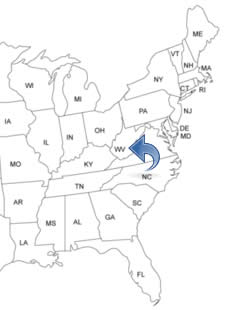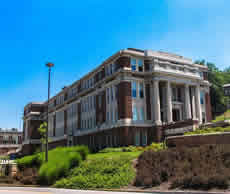WEST VIRGINIA PEOPLE SEARCH!
- ✔ Contact Info
- ✔ Phone Numbers
- ✔ Criminal Records
- ✔ Income Info
- ✔ Neighbors
- ✔ People's Age
- ✔ Property Ownership
- ✔ And Much More
Morgantown, West Virginia
Morgantown is located in the north-central part of West Virginia and is the third and the largest city in the U.S. State of West Virginia. It is home to the West Virginia University and has many cultural attractions. The metropolitan area has a population of 138,000. The city is today the commercial, medical, and cultural focal point of the region. Some say that the Joni Mitchell wrote the song "Morning Morgantown" after visiting the city. The Dominion Post is the only privately owned daily newspaper. The university have a student-run college newspaper, The Daily Athenaeum. That newspaper is published on weekdays.
To See And To Do In Morgantown
- The Art Museum of West Virginia University
- The Core Arboretum
- Deckers Creek Waterfall
- The Metropolitan Theatre
- The WVU Coliseum
- The Botanic Garden
- The Morgantown Brewing Company (MBC)
- The Iron Horse Tavern gastropub
- Farmers Market
- The Spark! Imagination and Science Center
- The Royce J. & Caroline B. Watts Museum
History Of Morgantown - Timeline
In 1758, Tobias, John, Garret Decker, and other families settled in today's Deckers Creek near present-day Morgantown. They built cabins and planted crops. In 1759, Indians attacked the settlers. Many of the original settlers were killed or captured in the attack but some escaped. A couple of years later many of the settlers returned. In 1766/1767, Zackquill and David Morgan came to the area. David and Zackquill had been there before together with the Decker brothers to fight Indians and Frenchmen before the Treaty of Paris in 1763.
In 1772, Michael Kern, buildt a one-story log house (Kern's Fort), and David and Zackquill built Fort Morgan at the present site of Morgantown. After that David moved to Fairmont. But Zackquill stayed and established a homestead near present-day Fayette Street and University Avenue. In 1773 and 1774, more forts were buildt in the area. In 1783, Zackquill opened the town's first tavern. Several families now lived in the town.
In 1784, a courthouse was erected, and on Oct 17, 1785, Zackquill Morgan named the establishment to Morgan's Town. In 1793, the Pittsburgh Gazette began delivering its newspaper to the Town. In 1795, the towns founder, Zackquill Morgan, died. In 1796, Jacob Nuce buildt the Old Stone House for the potter maker John W. Thompson. It is one of the oldest surviving stone houses in the area.
In 1803, the first grade school was buildt and the newspaper Morgantown Advertiser was established. In 1826, the first steamboat arrived. In 1838, Morgan's Town changed its name to Morgantown. In 1839, the Waitman T. Willey House was buildt. He was a politician and lawyer, and one of the founders of the state of West Virginia. In 1848, the courthouse was replaced by a two-story brick building.
In 1852, the Old Harner Homestead was buildt by Philip Harner. In 1854, the Vance Farmhouse was buildt. In 1857, the Rogers House was buildt. John Rogers was businessman who owned properties and saw, grist, and paper mills.
In 1860, judge Edward Bunker buildt the Alexander Wade house at 256 Prairie Street. Around 740 people now lived in the town. In 1863, the town became part of the new state of West Virginia. In 1864 the construction of the sawmill and grist mill "Easton Roller Mill" began. Also in 1864 the Morgantown Weekly Post was founded (The Dominion Post).
In 1866, the two-story brick house D.I.B. Anderson Farm was buildt on Collins Ferry Road. In 1867, the West Virginia University was established. In 1868, William D. Guseman, who owned a foundry, built the Ford House. John Wesley Ford purchased the house in 1902, and his family lived there until 1979.
In 1886, the Baltimore and Ohio Railroad reached the town. In 1891, the courthouse was once again rebuilt (the Monongalia County Courthouse). In 1896, the businessman and owner of the Dering Harness Company, Fred Dering, built the Dering Building. In 1898, the Brown Building was completed, and the Judge Frank Cox House was buildt. Frank Cox was a prominent lawyer and he also became the judge and president of the Supreme Court of Appeals of WV.
In 1900, nearly 2000 people lived in the town. In 1901, Morgantown was incorporated as a city. In 1902, the Lynch Chapel United Methodist Church was buildt. In 1924, the Metropolitan Theatre opened. The same year the first football stadium Mountaineer Field was established. In 1933, the American Italian mason and businessman Thoney Pietro (Ferdinando Pitassi) completed his dream home Pietro's Castle.
In 1941, the actor David Selby was born in Morgantown. He is perhaps most known as the ruthless businessman Richard Channing in the prime-time soap opera Falcon Crest. In 1975, the Morgantown Personal Rapid Transit opened. The system connects the three campuses of West Virginia University. In 1980, the Mountaineer Field at Milan Puskar Stadium opened.

